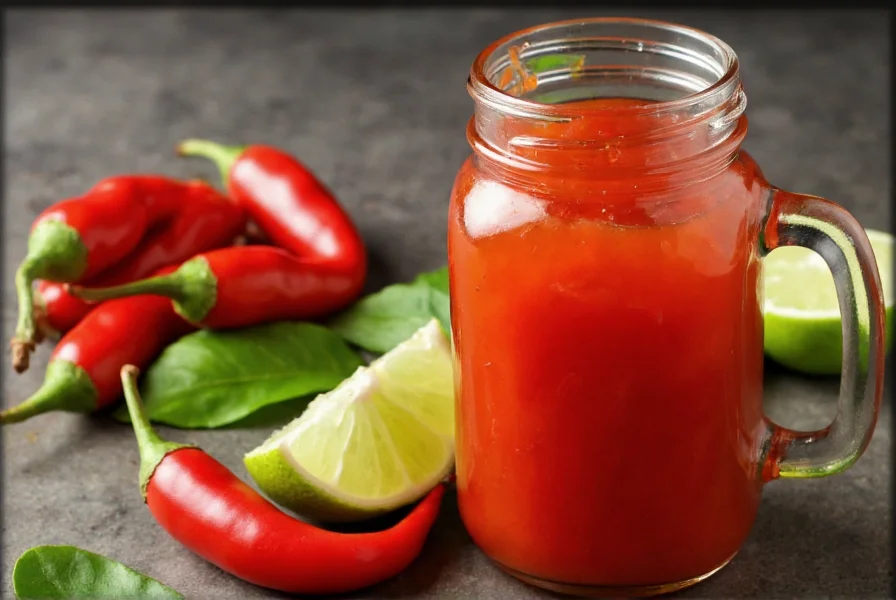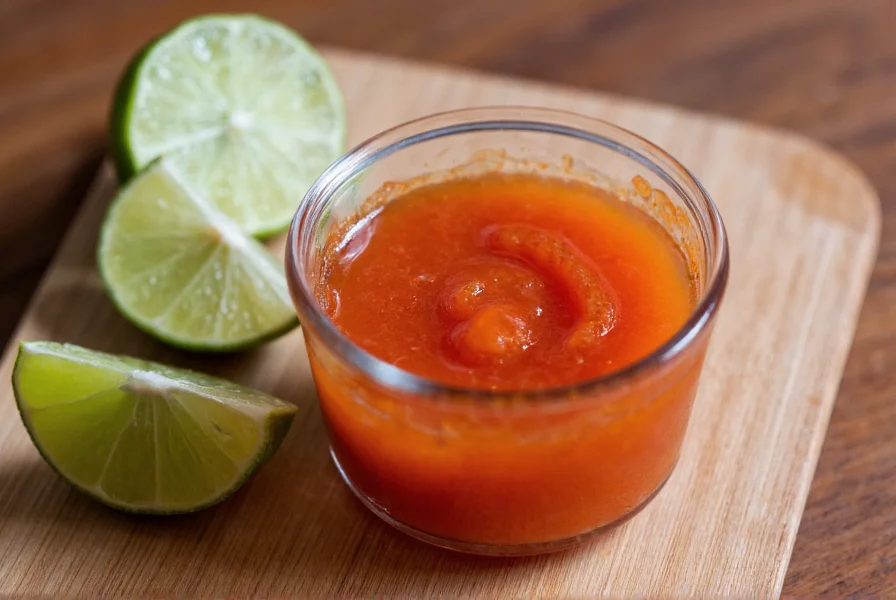Understanding what chili lime sauce is and how to use it properly can transform your cooking experience. This guide explores the essential components, culinary applications, and homemade preparation of this popular condiment that has become a staple in both traditional Mexican cuisine and modern fusion dishes.
What Makes Chili Lime Sauce Unique
Chili lime sauce stands apart from similar condiments through its balanced flavor profile. The combination of fresh lime juice's acidity, chili peppers' heat, and garlic's pungency creates a complex taste that enhances rather than overwhelms dishes. Unlike hot sauces that focus primarily on heat, chili lime sauce emphasizes the interplay between citrus brightness and mild spice.
Authentic versions typically contain:
- Freshly squeezed lime juice (not bottled)
- Guajillo or árbol chili peppers (providing moderate heat)
- Garlic (fresh, not powdered)
- Sea salt
- Water or citrus juice for consistency
| Component | Function | Common Substitutes |
|---|---|---|
| Lime juice | Acidity and brightness | Lemon juice, yuzu juice |
| Chili peppers | Heat and depth | Chipotle peppers, cayenne |
| Garlic | Flavor complexity | Shallots, onion powder |
| Salt | Flavor enhancer | Sea salt, kosher salt |
How to Use Chili Lime Sauce in Cooking
Knowing how to use chili lime sauce properly maximizes its flavor potential. This versatile condiment works as:
Marinade for proteins: The acid in lime juice helps tenderize meats while the chili adds flavor. For best results, marinate chicken, fish, or shrimp for 30-60 minutes before grilling. Avoid longer marinating times as the acid can make proteins mushy.
Taco finishing sauce: Drizzle over freshly assembled tacos just before serving. The sauce complements both traditional fillings like carne asada and modern vegetarian options. For authentic street taco experience, pair with fresh cilantro and diced onions.
Dipping sauce base: Combine with mayonnaise or sour cream to create a creamy chili lime crema perfect for dipping sweet potato fries, quesadillas, or grilled vegetables.

Simple Homemade Chili Lime Sauce Recipe
Creating your own chili lime sauce ensures freshness and allows customization of heat level. This basic recipe yields approximately 1 cup:
Ingredients:
- ½ cup freshly squeezed lime juice (about 4-5 limes)
- 2-3 dried guajillo peppers, stems and seeds removed
- 2 garlic cloves
- 1 teaspoon sea salt
- ¼ cup water
- 1 tablespoon honey or agave (optional for balance)
Instructions:
- Rehydrate dried peppers in hot water for 15 minutes
- Drain peppers and combine with remaining ingredients in blender
- Blend until completely smooth (1-2 minutes)
- Strain through fine mesh sieve for ultra-smooth texture
- Store in airtight container in refrigerator
This homemade chili lime sauce recipe creates a balanced condiment with moderate heat. For milder versions, reduce chili peppers to 1-2; for extra heat, add a pinch of cayenne or include seeds from one pepper.
Perfect Food Pairings for Chili Lime Sauce
Certain foods particularly benefit from the bright, tangy notes of chili lime sauce. Understanding these pairings helps you use the sauce effectively:
Seafood: The acidity cuts through richness of fish like salmon and enhances delicate flavors of shrimp and scallops. Try drizzling over grilled fish tacos or shrimp ceviche.
Grilled vegetables: Zucchini, bell peppers, and corn develop beautiful caramelization that contrasts wonderfully with the sauce's brightness. Toss vegetables in sauce before grilling for maximum flavor absorption.
Mexican street corn (elote): While traditional elote uses mayo and cotija cheese, adding chili lime sauce creates an extra dimension of flavor that elevates this popular snack.
Rice and grain bowls: A small drizzle transforms simple rice bowls into restaurant-quality meals. The sauce works particularly well with cilantro-lime rice bases.

Storage and Shelf Life Considerations
Proper storage maintains chili lime sauce's vibrant flavor and safety. When stored correctly in an airtight container in the refrigerator, homemade sauce typically lasts 7-10 days. The fresh lime juice acts as a natural preservative but eventually loses potency.
For longer storage, consider these options:
- Freeze in ice cube trays, then transfer cubes to freezer bags (up to 3 months)
- Add 1 tablespoon of vinegar to extend refrigerator life to 2 weeks
- Process in a water bath canner for shelf-stable preservation (requires proper canning knowledge)
Commercially prepared chili lime sauces often contain preservatives that extend shelf life to several months when unopened. Once opened, follow the "use by" date on the container, typically 2-4 weeks refrigerated.
Common Substitutions and Variations
When ingredients are unavailable or dietary restrictions apply, these substitutions maintain the essence of chili lime sauce:
Lime juice alternatives: Lemon juice provides similar acidity with slightly different flavor notes. For more authentic Mexican flavor, consider using a combination of lime and orange juice.
Heat level adjustments: For family-friendly versions, replace dried chilies with 1-2 teaspoons of smoked paprika. Those seeking extra heat can add a small amount of habanero pepper.
Creamy variations: Blend the basic sauce with avocado or Greek yogurt to create a rich, creamy version perfect for dipping. This chili lime crema variation works especially well with sweet potato fries and as a salad dressing base.
Understanding Commercial vs. Homemade Options
While store-bought chili lime sauce offers convenience, homemade versions provide superior freshness and customization. Commercial products often contain preservatives, thickeners, and additional sugars that alter the authentic flavor profile.
When selecting store-bought options, look for:
- Short ingredient lists with recognizable components
- No artificial preservatives or colors
- Real lime juice rather than citric acid
- Minimal added sugars
Many popular brands offer both traditional chili lime sauce and thicker crema versions. Understanding the difference between chili lime seasoning (dry rub) and sauce (liquid condiment) prevents recipe mistakes when following cooking instructions.
Frequently Asked Questions
What's the difference between chili lime sauce and Tajín?
Tajín is a dry chili lime seasoning, while chili lime sauce is a liquid condiment. Tajín contains chili peppers, lime, and salt in powdered form, designed as a rub or sprinkle. Chili lime sauce includes liquid components like fresh lime juice and water, making it suitable for drizzling, dipping, and marinating. You can transform Tajín into a sauce by mixing it with water or lime juice.
Can I use bottled lime juice for homemade chili lime sauce?
While fresh lime juice is recommended for optimal flavor, bottled lime juice works in a pinch. However, bottled versions often contain preservatives and have a slightly different pH that can affect the sauce's balance. If using bottled juice, choose a high-quality brand without additives and consider adding a small pinch of baking soda to neutralize any off-flavors from processing.
How spicy is traditional chili lime sauce?
Authentic chili lime sauce typically has mild to moderate heat, registering around 1,000-2,500 on the Scoville scale. The heat level depends on the type of chili peppers used - guajillo peppers provide mild warmth while árbol peppers create more noticeable heat. Most commercial versions aim for approachable heat that enhances rather than overwhelms other flavors in a dish.
What are the best tacos to serve with chili lime sauce?
Chili lime sauce complements virtually all taco varieties, but works especially well with fish tacos, shrimp tacos, carne asada tacos, and vegetarian options featuring grilled mushrooms or cauliflower. The sauce's acidity cuts through rich meats while enhancing delicate seafood flavors. For authentic street taco experience, drizzle the sauce over freshly assembled tacos with fresh cilantro and diced white onions.
Can I make chili lime sauce without garlic?
Yes, you can make garlic-free chili lime sauce, though you'll lose some flavor complexity. Substitute garlic with 1-2 shallots for milder allium flavor, or add a pinch of asafoetida (hing) for similar savory notes. For completely neutral flavor, increase the chili content slightly to compensate for the missing depth that garlic normally provides.











 浙公网安备
33010002000092号
浙公网安备
33010002000092号 浙B2-20120091-4
浙B2-20120091-4